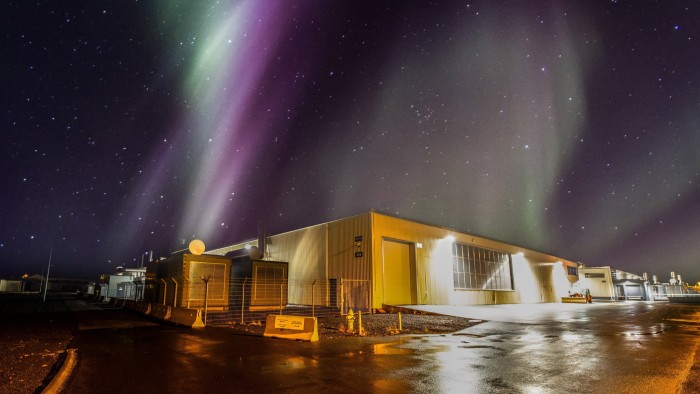Infrastructure investment trusts: a long-term bet


Roula Khalaf, Editor of the FT, selects her favourite stories in this weekly newsletter.
I’m a champion of the growing array of alternative investment trusts focused on providing an income. During the recent decade of near-zero interest rates, the sector grew exponentially as investors ploughed tens of billions into these funds, mainly targeted at infrastructure.
Many of the funds traded at a hefty premium to their net asset value but times have changed and this broad alternatives sector has fallen from favour in recent months. The culprit is obvious — increasing interest rates.
Put simply, if most of these funds offered an average yield of, say, 5.5 per cent, why bother taking that market risk when you can invest in a short- duration government security offering almost exactly the same yield, and no capital risk if held to maturity?
Higher interest rates have other knock-on impacts, notably declining net asset values (NAVs) as the cash flow models that underpin valuations are revised. And higher rates also mean higher loan servicing costs, although most funds have fairly long-term loan structures and many have hedged out their interest rate risk.
The trigger for higher rates — inflation — has helped many funds, particularly those with operating assets that produce inflation-linked returns. But there’s a lag on that inflation upside and it has in any case been insufficient to compensate for the impact of soaring rates.
Worse may be to come in the short term. There is a decent chance that UK interest rates and thus short duration UK gilt yields will head even higher — possibly by as much as another 1 percentage point. With average discount rates running for most funds at around 7.4 per cent, analysts at Numis reckon another 100 basis points on the discount rate could cut already diminished NAVs by an extra 8 per cent.
Other niche-specific factors could also come into play. One renewables-related driver has been plunging power prices in the first half of this year. Small-scale funds could find themselves spurned by investors while more than a few might struggle to cover dividend payouts.
So even though the infrastructure trust sector generally looks cheap at a discount of 17 to 20 per cent, and a yield running at around 6.5 per cent, it could come under increasing strain in the short term.
But I would maintain we are fast approaching the trough, if only because at some point in the next 18 months, the Bank of England will have to reduce those interest rates, probably back to a range of 3 to 5 per cent. Why? Although most commentators tend to focus on the threat that longer-term high rates pose to government finances, the real danger is that they kill corporate investment stone dead, slashing long-term growth rates.
If, like me, you think both interest rates and inflation will head back to between 3 and 5 per cent in 2024 or shortly after, the current pricing for funds looks attractive. Implied median real returns from the sector are currently running at 5.3 per cent, say the analysts at Numis.
So how to navigate this treacherous market? These are the most interesting long term (and short term takeover or turnround) bets on the broad alternative sector.
NAV quality play
As rates are set to stay higher for longer, investors will focus less on the headline dividend yield and more on the ability of the fund to grow its net asset value through operational improvement. This requires investors to look past the yield at the record of the fund when it comes to boosting operating profits, which will then hopefully yield higher dividend payouts in the future. My favourite fund in this respect is 3i Infrastructure, with investments that have a very strong record. It has one of the lowest discounts in the sector and it recently raised extra money, a sign of investor confidence.
Takeover targets
Some funds have found themselves in trouble because of a series of self-inflicted events. In this category is digital infrastructure fund Digital 9, which invests in everything from underwater fibre cables to Nordic data centres. It has now crashed to a discount of more than 40 per cent. The fund manager left and the fund also bought a big stake in a business called Arqiva, which runs Britain’s digital broadcast infrastructure. D9 used lots of debt, just as investors started to fret about expensive leverage. Investors have run for the hills but D9 has a very solid portfolio of operating businesses, in sectors where recent private equity deals have motored ahead on rich multiples. My guess is that after the board cut its dividend, a private equity player will pounce and buy the quality assets, especially its fast-growing Icelandic data centre business.
Alternative Income
Alternative income funds generate their dividends from lending money at high rates to niche borrowers. Biopharma Credit, for instance, lends to established but growing life sciences firms to fund new products. Its record on lending is excellent and it has a long list of loans that have repaid early, triggering extra fees. The fund usually trades close to NAV but has fallen back as investors worry about one loan position. I think this will be resolved profitably but in the meantime you get access to a fund with a great record yielding 8 per cent on a near 10 per cent discount.
Growth plus
Not every infrastructure fund is totally focused on defensive sectors, or just on income. Some niches are more growth oriented, where the operating business expects long-term secular growth in demand and higher profits. One is the battery storage sector, where the growing use of renewables on the grid will require energy storage via batteries. The market is growing fast and there are three funds focused on this space — Gresham House Energy Storage (where I am a non-executive director), Harmony and Gore Street. All three now trade at discounts, in part because of declining power prices. But the growth prospects are unchanged.
Recovery play
My last category is for funds where I simply think the record is impressive but the market is overegging the downside risks or, put another way, the NAV discount is over the top. If all goes to plan, that discount should fall back to between par and -10 per cent over the next year as investors realise how dependable the underlying business units are, as well as the operating cash flows. In this category I’d focus on two funds. Cordiant Digital is a competitor to D9 and currently trades at a 23 per cent discount, which I think is excessive given the core businesses, mostly in central Europe. I’d also highlight Greencoat UK Wind which has a long record of solid cash flows, but trades at a discount of 18 per cent.
David Stevenson is an active private investor. He holds shares in 3i Infrastructure, Digital 9, Cordiant, Gresham House Energy Storage, Gresham House Energy Storage and Harmony. Email: adventurous@ft.com. Twitter: @advinvestor.
Comments